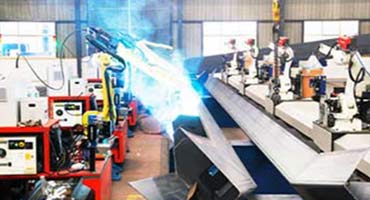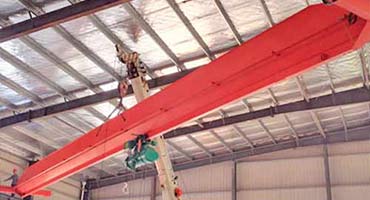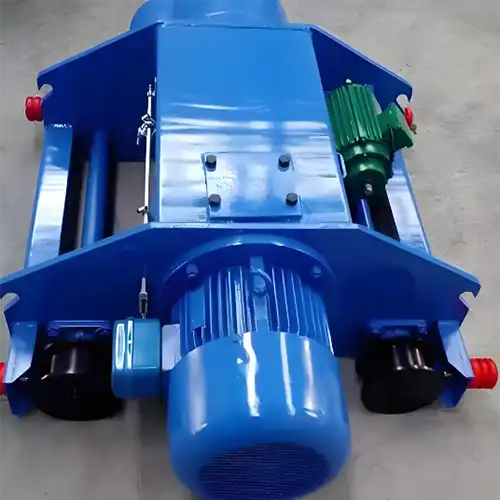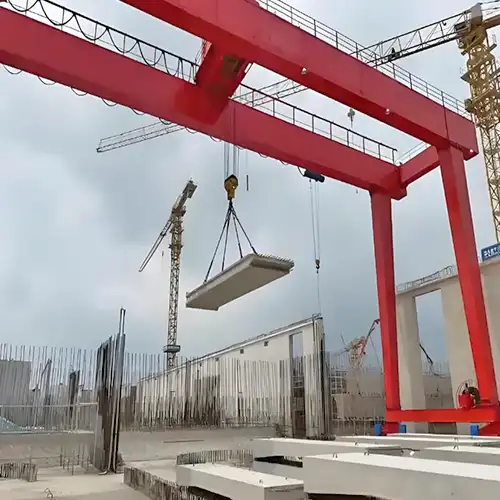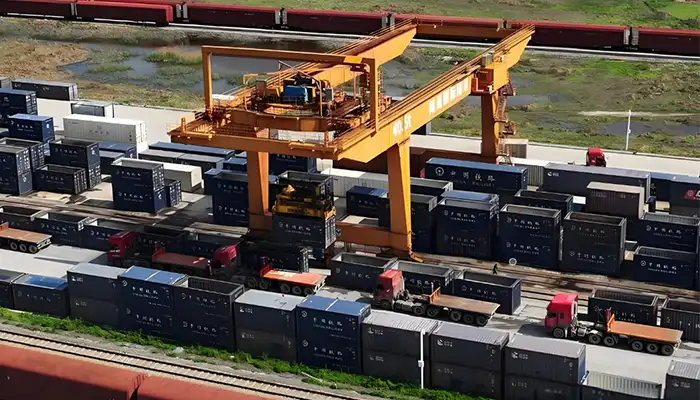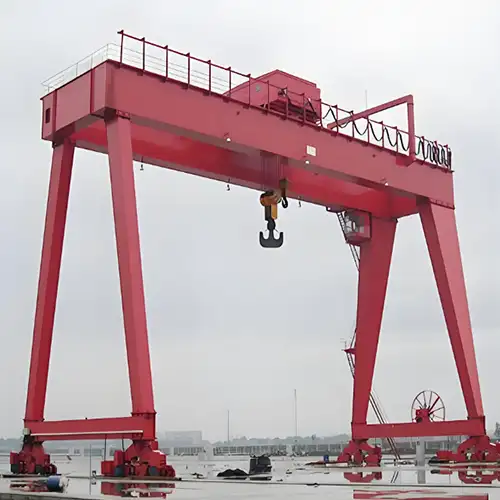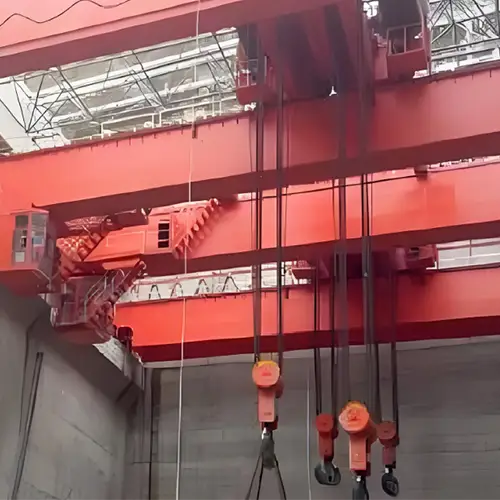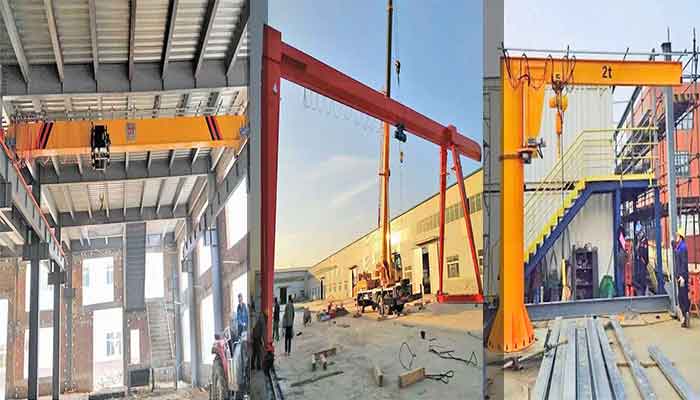
Types of Cranes: Overhead Crane Types, Gantry Crane Types & Jib Crane Types
Types of cranes overview, including main types of overhead cranes, types of cranes specifications, advantages, applications are presented for you to select the right type of crane.If you've done your homework and determined that an overhead crane system could help your facility's manufacturing or material handling processes, you're certainly aware that cranes come in a variety of shapes and sizes. Your mind may be racing as you try to make sense of all the information available, and you may be wondering, "What type of crane do I need for my business?"
In terms of specifications and designs, overhead cranes come in a wide range of options. There are no two cranes that are the same! A crane that has previously functioned in a similar structure or lifting application may not be the optimum crane for your facility or application. To maximize productivity, streamline workflow, and get the most bang for your buck, choosing the proper crane for your organization is important.
What are the types of overhead cranes?
In your mind's eye, a bridge crane is made up of two overhead runways integrated into the building's support structure and connected by a single or double beam configuration known as a "bridge." The bridge is supported on both ends by an end truck, which travels up and down the bay on wheels along a runway or beam.
A bridge crane can have a single girder or a double girder configuration. A bridge girder, also known as a beam, is the structural support that permits the trolley and hoist to travel from side to side along the bridge. Before lifting or lowering a weight, the trolley is utilized to properly place the hoist.
Overview of types of overhead cranes
Overhead travelling cranes are lifting equipment intended for the workshop or workstation to transport loads or objects which work in the intermittent system. Equipped with mechanisms for lifting up and lowering loads – hoists or winches, the overhead travelling cranes are able to transport loads to a desired place.
Main configuration of Overhead travelling Cranes

Overhead gantry crane
Overhead gantry crane/ Goliath crane – when overhead gantry crane moves on the rails including, full gantry/ double leg gantry cranes & semi gantry / single leg gantry cranes.
- Crane capacity:5 ton -500 ton
- Crane span:12~35m
- Lifting height:As your request
- More on Types of Gantry Cranes.

Travelling bridge crane
Overhead Crane or Travelling Bridge Crane – when the travelling crane moves over the ground rails and its bridge is situated over the rails
- Crane capacity: 1 ton- 550 ton
- Crane span:≥ 31.5m
- Lifting height:As your request
- More on Types of Overhead Bridge Cranes

Suspension crane
Suspension crane/ Underslung crane / Under-hung crane– when it is suspended to the rails from the bottom.
- Crane capacity: 1~10t
- Crane span: ≥ 6m
- Lifting height: As your request
- More on Types of Suspension Cranes

Overhead jib crane/ Slewing crane
Slewing crane/ Jib crane- cantilever overhead travelling crane with wall mounted type or pillar mounted type.
- Crane capacity: 0.25 ton-16 ton
- Lifting height: up to 30 m
- Arm length: As your request
- More on Types of Jib Cranes
Overhead cranes - perfect lifting solution for your business!
Our standard overhead crane serial include single /double girder overhead crane and suspension crane. And also, the tailored crane solutions based on your special industry needs is what make us differentiate.
0.25 ton to 550 ton overhead cranes for wide industrial applications. Types of overhead cranes with different crane configuration, ie, Top running overhead cranes , Under hung or overhead cranes, and free standing overhead KBK cranes, with various crane bridge girder designs, including single girder, double girder ,box girder, Beam girder, monorails, etc., are manufactured and supplied for industrial material handling in various workshops and workstations, etc.
Contact us to get free overhead crane specifications pdf and competitive custom designed overhead crane price now.
Overhead bridge travelling crane / Overhead cranes / Overhead EOT crane
Overhead cranes also Travelling Bridge Cranes are the most widely used lifting equipment in various industries. The bridge travelling cranes consists of parallel runways with a travelling bridge girder , mounted to crane end trucks / end carriages which are equipped with wheels thanks to which the overhead travelling crane moves on the rails. And along with the bridge, there is the rope or chain system, a hoist or a winch for raising the load on the crane hook or another lifting attachments.
The biggest difference between a single girder and a double girder bridge construction is how high your hoist can elevate above the ground.
In your mind's eye, a bridge crane is made up of two above runways integrated into the building's support structure and connected by a single or double beam configuration known as a "bridge." The bridge is supported on both ends by an end truck, which travels up and down the bay on wheels along a runway or beam.
Single Girder vs. Double Girder Bridge Cranes
A single girder or double girder design is available for an overhead bridge crane. A bridge girder, also known as a beam, is the structural support that permits the trolley and hoist to travel from side to side along the bridge. Before lifting or lowering a weight, the trolley is utilized to properly place the hoist.
Both single and double girder cranes are strong and durable to some extent. The biggest difference between the two is hook height, or how high your hoist can elevate above the ground. Because the hoist is located on top of the girders rather than below them, a double girder crane can provide more hook height.
A double girder or single girder configuration may be the best option in various situations. We'll go over a few of these examples below:
Single Girder Crane Types – The bridge is made out of one girder beam with an end truck on each side. Most trolleys and hoists are underhung, which means they run on the bridge's bottom flange. They are also less expensive as a result of:
For lifts under 20 tons and spans less than 32 meters, a single girder bridge crane is ideal. Because only one girder is required to move the trolley, a one girder overhead crane is more cost effective, saving freight costs and allowing for faster installation. A twin girder structure, on the other hand, may be the preferable option if the crane must handle more than 20 tons or the span is greater than 32 meters.
Double Girder Crane Types – The bridge is made up of two girder beams, each of which is supported by an end truck on each side. The trolley and hoist are attached to a rail that runs along the tops of the bridge girders. Double girder cranes are suitable for applications requiring greater than 20 tons of lifting capacity or a span of more than 32 meters.
Walkways, cabs, magnet cable reels, and other specialized equipment can be added to double girder bridge cranes. When the crane needs to be customized with walkways, cabs, magnet cable reels, or other specialist equipment, double girder cranes are the ideal alternative. They can also provide additional lifting height with a top-running design because the hoist isn't dangling underneath the beam.

Single girder overhead crane
Single girder overhead crane designs, various single girder crane hoists, economical single girder overhead crane price, ideal overhead travelling crane solution.

Double girder overhead crane
Double girder overhead cranes -overhead travelling hoist crane & open winch crane - with below the hook lifting devices, grab, magnet, spreader,C hook, etc.3
Top Running vs. Under Running Cranes
When it comes to distinguishing between bridge cranes, you should evaluate whether you need a top-running or under-running crane. The bridge runs on tracks along the top of the runway beams on a top running crane.
The wheels travel down the bottom of the lower beam flange on an underrunning, or underhung crane, and the bridges are supported by the bottom of the runway beams.
Top running crane types – These cranes have no limited capacity, which means they can be built to handle loads ranging from little to very heavy. They have a rail put on top of each runway, and the bridge wheels move along the rail rather than the runway beam's bottom flange. These cranes are suited for transporting exceptionally big loads and are supported by the building structure or runway support columns, or sister columns.
A top running bridge crane is extremely versatile, as it has no limiting capacity and may be built to handle both small and big capacities. Top-running cranes can be built with a single or double-girder structure.
Under running crane types – A top running bridge crane is extremely versatile, as it has no limiting capacity and may be built to handle both small and big capacities. Top-running cranes can be built with a single or double-girder structure.
Under running cranes, also known as under hanging cranes, are primarily built for lighter service and smaller capacity applications, and provide good side approach when supported by ceiling or roof structures. When supported by roof or ceiling structures, the underrunning crane is often built for lighter service / lower capacity applications. It provides good side approaches and maximizes exploitation of the building's width and height. However, because the bridge and hoist are suspended beneath the runways, the hook height is lower than top running.

Top running overhead crane
With top running crane design, the overhead travelling cranes run on a fixed rail or track system on the top of each runway beam. The top running cranes can be designed in a single girder overhead crane or double girder overhead crane configuration which are optimal for extremely heavy material handling.

Underhung overhead crane
An under running crane are also named underhung crane or underslung crane whose end carriages/ end trucks travelling on the bottom flange of the runway beam, which enables the crane bridge girder running under the crane runway, Under running overhead cranes can be designed into verious types such as single girder underhung crane& double girder underhung crane, monoral underrunning crane, kbk under running crane, etc.
Process Cranes vs. Modular Cranes
Bridge cranes are classified into two groups based on their purpose, capacity, and operating environment. "Process" cranes and "Modular" cranes are common terminology for the two types of cranes. Below, we'll go through each of these terms in further depth:
Process Cranes Types— A process crane is designed to meet a specific demand, and these cranes are heavy-duty and operate continuously or nearly continuously. They're usually a top-running, double-girder design with a lot of engineering built in to execute high-capacity lifts or repeat a very specialized duty. Process cranes can be found in areas like auto assembly facilities, steel mills, container yards, and timber mills, and can lift 10-20 tons per hour at 50-75 percent of their rated capability.
General Use Crane Types- The general use crane, also callled Modular cranes, which are often found in smaller manufacturing facilities, mills, or machine shops, and feature a design that consists of a more basic-level hoist, trolley, and bridge. They're low-cost, low-cost ways to move materials through a plant, and they usually don't come with a lot of extra bells and whistles.
Single Girder Overhead Travelling Bridge Crane
- Chinese Type Robust & Economial Single Girder Hoist Overhead Crane
- European Standard Small & Light-weighted Hoist Single Girder Overhead Crane
- Suspension Crane, Ceiling-mounted Single Girder Overhead Crane
- European Type Underslung Crane
- Explosion proof type Single Girder overhead crane
- Low Headroom crane type Single Girder Overhead Crane
Applications
- The bridge travelling overhad cranes is one of the most common type of electric travelling cranes , which are used widely for material handling between fixed span, with the largest number of variotions of crane specifications.
- Widely applied in carrying, lifting, assembling and unassembling of general weights,and loads, and also can be used for special operation with special designed hoists. .
- The general used bridge travelling overhead cranes are not supposed to in the hazardous environment such as easily combustible, explosive, corrosive (acid, alkali, plating, steam, etc.).
Other Types of cranes
Based on standards or terms, the lifting cranes also can be classified into various types, which are presented for your reference. If the overhead crane you need is not prsend in the following, please feel free to contact us. Customized cranes are available for you. WhatsApp/ WeChat: + 86 151 3871 1597.
Main types of overhead travelling cranes
By mounted types
Processed craneBy crane lifting system
By lifting devicesTypes of industrial use cranes
By crane capacity & Specs
- 1 ton, 2 ton, 3 ton, 5 ton
- 10 ton, 15 ton
- 20 ton, 25 ton
- 30 ton, 35 ton
- More crane capacity & specifications
Gantry Crane
Gantry crane is a variant of travelling bridge overhead crane. Gantry Cranes or Goalith Cranes are widely used in open air yard or indoor material handling , such as, in steel stock yards, pre-cast segment yards, construction sites and other outdoor application, with no need of a supporting building or steel work, but instead, the gantry cranes with one or two beams are supported on steel gantry legs, on gantry beam, there is a trolley to lift and transfer across, and the whole structure of which looks like a big gate, so it is called Gantry Cranes. .
As a gantry crane manufactuer and supplier, we have various types of gantry cranes & goalith cranes for sale. Types of Full Gantry Cranes and Semi Gantry Cranes with various gantry girder designs, such as, single gantry girder, double gantry girder,box gantry girder, truss gantry girder and beam gantry girder, etc. , which is mounted on rail, rubber tyre, or rollers, etc.
A complete range of gantry cranes are provided i.e. single girder & double girder designed double legged full gantry cranes, single girder & double girder designed one leg semi-gantry cranes and small gantry cranes including, portable gantry cranes,adjustable gantry cranes and fixed height steel gantry cranes, and other types of gantry cranes, etc.Contact us to get your customized gantry crane at very competitive gantry crane price now.

Full gantry crane types
The full gantry cranes refer to the gantries has both rail tracks at ground level with options to pass through the gantry legs with cantilevered sections. The full gantry cranes are used when the overhead travelling bridge crane is difficult to applied.

Semi gantry crane types
A Semi-Gantry Crane is also named single-leg gantry crane, with one gantry leg running on the rail track at the ground level, while the other end runs overhead on a wall-mounted I-beam.
Full gantry crane vs. Semi gantry crane
First, normally, gantry cranes are divided into double legged full gantry crane, single legged semi-gantry crane with or without crane cantilever, and the main feature of the each type of gantry cranes are as following:
- Full gantry crane types: The full gantry cranes refer to the gantries has both rail tracks at ground level with options to pass through the gantry legs with cantilevered sections. The full gantry cranes are used when the overhead travelling bridge crane is difficult to applied.
- Semi-gantry crane types : A Semi-Gantry Crane is also named single-leg gantry crane, with one gantry leg running on the rail track at the ground level, while the other end runs overhead on a wall-mounted I-beam. The semi gantry crane is usually used in the facilities with issues of machinery, narrow spacing or confined spaces, and also it can be used below the existing bridge overhead travelling cranes , offering exceptionally extensive cover of the floor area.

Single girder gantry crane types
The single girder gantry crane has the features of simple structure, easy manufacutering and installation, , smaller mass of its own but with weaker overall stiffness , compared with that of double girder gantry cranes.

Double girder gantry crane types
Double girder gantry crane has strong bearing capacity, long span, larger overall stability, and many varieties whereas the quality of the double girder gantry crane is larger and their gantry cost is higher compared with single girder gantry cranes with the same weight
Double girder gantry crane vs.Single girder gantry crane
- Double girder gantry crane is one of the most common type of gantry structure, with the advantage of high structural force and effective use of the site area. Double girder gantry crane has strong bearing capacity, long span, larger overall stability, and many varieties whereas the quality of the double girder gantry crane is larger and their gantry cost is higher compared with single girder gantry cranes with the same weight.
- Single girder designed gantry cranes is often selected by site constraints. The single girder gantry crane has the features of simple structure, easy manufacutering and installation, , smaller mass of its own but with weaker overall stiffness , compared with that of double girder gantry cranes. Single-gantry gantry cranes have two different gantry leg designs, the L-shaped legs and C-shaped door legs. The weightof the L-shape leg gantry crane is small but with ralatively smaller space for lifting cargo going through . The C-shaped leg gantry crane are designed with inclined or curved legs, providing a large lateral space for the loads to go through.

Box girder gantry crane types
The box girder of the gantry crane is welded with steel plates into a box shape structure, used for gantry crane with large tonnage and oversized design, with advantages of high safety, stiffness and other characteristics and with shortcomings of high cost, heavy self weight, and poor wind resistanc

Truss gantry crane types
The truss girder of gantry cranes is welded by angle steel or I-beam, with the advantages of low cost, light weight, and good wind resistance, whereas with the disadvantages of large deflection, relatively low rigidity & reliability, and frequent detection of welding spots, due to large welding points, which is ,usually used in the application with low safety requirements and smaller lifting weight.
Box girder gantry crane vs. Truss girder gantry crane
- Box girder gantry crane type: The box girder of the gantry crane is welded with steel plates into a box shape structure, used for gantry crane with large tonnage and oversized design, with advantages of high safety, stiffness and other characteristics and with shortcomings of high cost, heavy self weight, and poor wind resistance.
- Truss girder gantry crane type: The truss girder of gantry cranes is welded by angle steel or I-beam, with the advantages of low cost, light weight, and good wind resistance, whereas with the disadvantages of large deflection, relatively low rigidity & reliability, and frequent detection of welding spots, due to large welding points, which is ,usually used in the application with low safety requirements and smaller lifting weight.

Rail mounted gantry crane types
Gantry cranes running on track rail over a fixed route for transferring heavy loads,by manual or motorized.power supply

Portable gantry crane types
Portable gantry crane is a small gantry crane which can be relocated, with featured as flexiable, fast, easy movement to and from a designated work site
Rail mounted gantry crane, vs. Portable gantry crane
Gantry cranes also can be grouped into different gantry crane types, in terms of gantry designs, including:
- Rail mounted gantry crane is gantry cranes running on track rail over a fixed route for transferring heavy loads,by manual or motorized.power supply
- Rubber tyred gantry crane is a type of portable gantry crane with high movibility with gantry crane mounted on rubber tryed wheels.
- Portable gantry crane is a small gantry crane which can be relocated, with featured as flexiable, fast, easy movement to and from a designated work site.
Applications of gantry cranes
Gantry cranes is usually used when the the overhead bridge crane is not practical or is not cost-effective. For explemes, the gantry crane is a better choice when the existing workshop structure cannot support the wheel loads of the overhead bridge crane, or when the loads need to be handled outside the crane span or when the lifting crane relocation is required when the work at a certain site is finished. Comparatively, gantry cranes are more cost-effective than the overhead bridge crane system.
Gantry cranes / Goliath cranes are widely used for cargo stansfering and installation works in freight yards, open-air storage yard, ports docks, railway stations, and power plants, etc.
Due to the long crane span, gantry cranes are usually applied by respective driven way to keep the gantry girder crane from producing skewed running and at the same time increasing the resistance, preventing accidents.
On gantry crane girder designs
- Box girder gantry crane type
- Box type single girder gantry crane
- Box type Double girder gantry crane
- Truss type single & double gantry crane
On gantry crane leg design
Gantry mounted type:
Types of small gantry cranes
Jib cranes
0.25-20 ton jib cranes for sale. Types of jib cranes are manufactured and supplied with various jib crane designs, such as Pillar cranes, such as floor mounted jib cranes & post jib cranes, etc., Wall crane series, including wall mounted jib cranes & wall travelling jib crane, slewing jib cranes , fixed jib & mobile jib crane, etc.
Jib cranes are the optimal lifting equipment for short transfer applications. We can provide you the wall travelling jib crane, pillar jib crane and wall mounted jib crane, etc. We jib cranes can lift and transport materials in semi circles or full circles around their support structures to provide localized material handling in work cells, to supplement a large overhead crane system, to transfer materials from one work cell to another, and to lift a line load up to the rated capacity safely.
- Wall jib crane -The wall jib cranes can be grouped in wall mounted jib crane & wall travelling jib cranes with the different cantilever designs such as Cantilever jib crane design & Tie-Rod Supported jib crane designs.
- Freestanding jib crane/ Floor mounted jib crane -Floor mounted jib crane also named floor jib crane or free standing jib crane is one of the popular types of jib cranes which is usually mounted on the ground floors, grouped into the concrete foundation type jib crane and foundation-less jib cranes,etc.

Free standing jib crane
The wall jib cranes can be grouped in wall mounted jib crane & wall travelling jib cranes with the different cantilever designs such as Cantilever jib crane design & Tie-Rod Supported jib crane designs.

Wall jib crane
Freestanding jib crane/ Floor mounted jib crane -Floor mounted jib crane also named floor jib crane or free standing jib crane is one of the popular types of jib cranes which is usually mounted on the ground floors, grouped into the concrete foundation type jib crane and foundation-less jib cranes,etc.
Applications of Jib crane
Jib cranes are widely used in workstations, storage, yard and other fixed or localized places, etc. Jib cranes are the choices for material handlings in short-distance or serried places, such as, transferring materials from one work cell to another. Jib cranes can be used to supplement a large overhead crane for material handling.Jib cranes can be used for suspension of tools.Jib cranes also can be used for economical outdoor applications.Jib cranes are not allowed to be used in dangerous applications such as inflammable, explosive, and corrosive working environments, etc.
Advantages of jib cranes
As a newly developed material handling equipment, jib cranes can be used freely in three dimensional space.Jib cranes are designed with special structure, high safety and reliability, high efficiency, which can save your energy and time.Jib crane covers small working area, and is easy to operate and maintain, rotary flexible, economic and durable.
Types of jib cranes offering
- Small jib crane
- Portable jib crane
- I-Beam jib crane
Various of Crane Services
Various types of process cranes are available for material handling in foundry factory and foundry plants through the process of raw materials handling, machining, fabricating, shaping and finished products handling, transportation and storage, etc.

